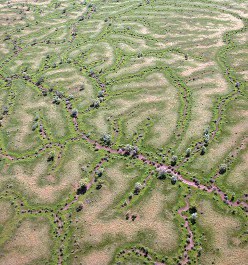|
|
Cycles, spheres, energy and connectivityTo manage an ecosystem, it is important to understand what it is made of and how its various parts work and interact. Appreciating how the various parts or components work and interact (the processes) helps managers to identify, plan and manage all the aspects of a wetland that enables it to deliver the many services that people depend on and value. Components and processes also form parts of elemental, nutrient and biological cycles, and make it possible for parts of the system to connect – known as aquatic ecosystem connectivity. Aquatic ecosystem connectivity refers to the connections between and within aquatic ecosystems.
SpheresThe earth can be regarded as a system of interconnected sub-systems termed spheres. To help understand how components and processes work, where they are located and what role they play in the functioning of aquatic ecosystems, the concept of spheres can be used to organise components and processes. CyclesCycles are a collection of on-going repetitive processes in which components are continuously cycled in various forms (such as air, water, soil, organisms). Examples include the carbon, nitrogen and phosphorus cycles (nutrient cycles), energy cycles and the water cycle[4]. Cycles involve energy flows that transform matter from one form to another[4].
Cycles involving energy and matter are necessary for life as components such as water, air, carbon, nitrogen, oxygen and phosphorus circulate through global reservoirs or sub-systems (spheres). These reservoirs are the biosphere (the living portion of our planet), the atmosphere, the hydrosphere, and the geosphere. The cycling of components determines the environment for life, such as the circulation and provision of water through the water cycle[1][3]. EnergyAll processes on earth require energy. Energy is present in the landscape in many forms and energy flow is involved in most ecological processes. Energy flow is involved in atmospheric, hydrological, geological, nutrient and life cycles and processes. Energy is a physical quantity of heat applied to, or work that can be done, on an object, usually measured in ergs (cgs) or joules (mks)[3]. Energy can be stored by a system, objects or within the landscape, and can be transferred or converted from one energy store to another. As the energy flows from one store to another, it can perform work on an object or induce change in matter composition. Energy is involved in the cycling of matter[5]. Energy stored in a system or object is potential energy, and energy is transferred through kinetic energy. Kinetic Energy: The energy possessed by an object in motion. Potential Energy: The energy stored in an object or system, such as gravitational potential energy, electromagnetic or nuclear potential energy. There are many different ways energy can be transferred between the stores in a system[5]:
Energy from the sun includes radiation, solar and thermal energy[2]. Energy flow in biological cycles and processes starts as solar radiant energy from the sun, and moves to chemical energy transfers through primary producers (heterotrophs, i.e., plants) primary consumers (herbivores), secondary consumers (carnivores) until it becomes detritus (non-living organic material) where decomposers (or detritovores) derive their energy. Energy at all levels also radiates into space, and cycles through the ecosystem. Pages under this sectionReferences
Last updated: 9 October 2023 This page should be cited as: Department of Environment, Science and Innovation, Queensland (2023) Cycles, spheres, energy and connectivity, WetlandInfo website, accessed 18 March 2024. Available at: https://wetlandinfo.des.qld.gov.au/wetlands/ecology/components-processes-drivers/ |

 — Department of Environment, Science and Innovation
— Department of Environment, Science and Innovation


